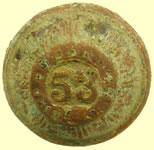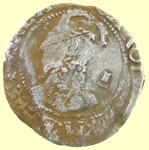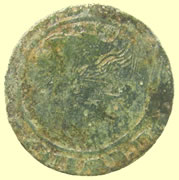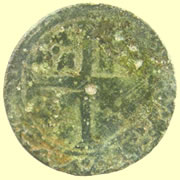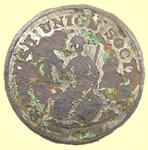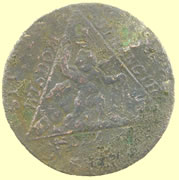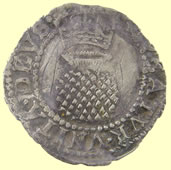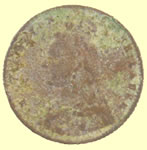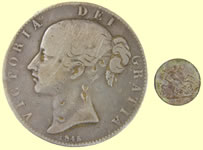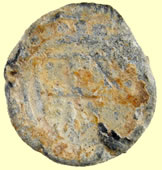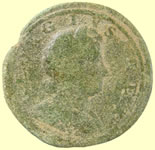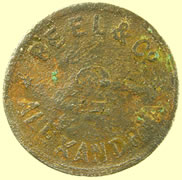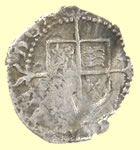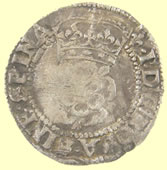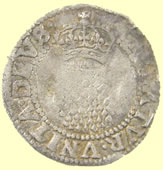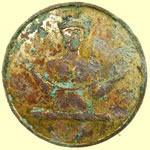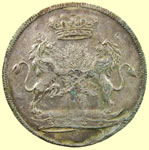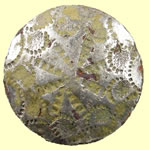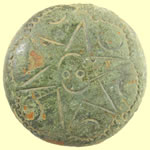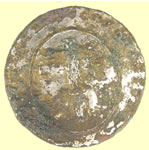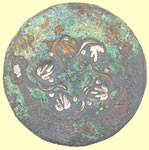25th Feb 2009 More updates and finishing 'cooking'
Japan's sewers paved with gold
I finished 'cooking' the medieval silver penny find below and it the first one I have ever seen with 'horn' crust (silver chloride) growing on it like a Roman silver. The soil conditions must have caused this reaction and I used the same 'mix' that I used for cleaning Roman silvers, it took 2 weeks of 'cooking' to bring out the detail. I don't intend to cook it further as the coin is laminating. I have updated more pages with the latest finds below.
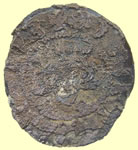 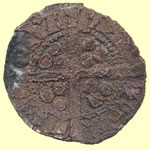  
1341 Edward III hammered silver penny - Florin type
obv EDWAR ANGLE DNS HYB
Rev CIVI/TAS/EBO/RACI - York mint
17.90mm, 1.09g
|
24th Feb 2009 More updates and a few more finds
 Updated both the Charles 1st and 2nd individual finds pages with the latest finds and a few more finds I missed including this stonking 88th Regiment of foot button. It is not listed in my ref books but it is circa 1790. Updated both the Charles 1st and 2nd individual finds pages with the latest finds and a few more finds I missed including this stonking 88th Regiment of foot button. It is not listed in my ref books but it is circa 1790.
'The regiment was raised on 25 September 1793 from the men of Connacht by John Thomas de Burgh, 13th Earl of Clanricard.The 88th Foot served in the Peninsular War (1808-1814), and in the Crimean War (1854-1856), where their service was recognised by the presentation to the City of Galway of a pair of guns in memoriam, which until recently remained on prominent display on the city's main square, Eyre Square, and now are displayed outside City Hall.After the Crimean War, the 88th returned to Britain. In response to the Indian Rebellion, the 88th were soon deployed to India.'
|
|
|
Georgian harness mount |
Victorian lion head mount - 2 integral lugs |
Napoleonic Navy button ? |
|
|
|
Georgian hinge |
18thC Royal artillery button |
Georgian bell clapper |
|
23rd Feb 2009 Updating pages - fixed finds
Updated the latest finds to the individual pages.
 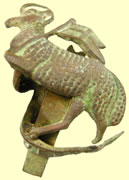
Idaho Orv just posted a picture of his Queens regiment cap badge find he repaired when his finds were shipped back home, what a great job.
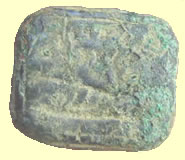 
Idaho Jerry sent me a picture of his seal matrix find that he cleaned up and pushed into wax and it shows the word 'god speed' and what appears to be a plough underneath, neat relic.
|
22nd Feb 2009 Boy Bishops tokens
I have just uploaded the last of the finds including another Medieval Boy Bishop token found by can Rod on the same area of land that the large one he got last season was on. This area also produced some ecclesiastical silver coins so where the local church having an outing here ? This is only the 3rd one we have found so it is a rare find for this area. Updated the lead tokens pages
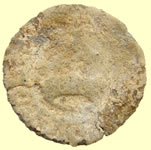 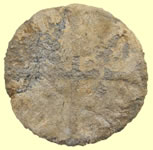
Medieval Boy Bishop lead token
Obv Long cross and pellet
Rev Bishop mitre
During the Middle Ages, as part of the Christmas celebrations, churches and abbeys used to elect a choirboy as Boy Bishop.
He would hold office from St Nicholas' Day, on December 6, to Childermas or Holy Innocents' Day, on December 28, when he preached a sermon and then resigned.
During this period the choirboy was treated exactly as a real bishop would have been. He wore the bishop's robes, preached sermons and headed a procession in his honour but was not allowed to celebrate Mass.
The custom honoured St Nicholas, the patron saint of children, who lived during the 4th century at Lycia in what is now Turkey, where he was Archbishop. He had inherited a great fortune and gave much of it away, anonymously, particularly to children. St Nicholas also gave rise to the legend from which the notion of Father Christmas was born.In some European towns and cities, the Boy Bishop gave away lead tokens.In Britain this practice was confined mainly to East Anglia. Bury St Edmunds was the main centre but tokens from Sudbury, Ipswich and Ely are also in existence. The Boy Bishop ceremony was in existence in Bury by 1418 but the earliest tokens date from about 1480.
They were probably exchanged for sweetmeats or alms at the Abbey almonry or by charitable local tradesmen and merchants. Tokens sometimes turn up on old footpaths and on Medieval market sites, which suggests that they were also used as small change.
The design of Bury's Boy Bishop tokens was based on the regular coinage. They were made of lead alloy and came in three sizes – penny, half groat (2d), and groat (4d). The half groat is the least common. The neatest pieces are probably the earliest. The obverse (heads) usually shows a mitre or the head of St Nicholas and carries a legend asking for his prayers. The reverse (tails) is often marked with the legend Ave Rex Gentis, which refers to an anthem sung to St Edmund in Bury Abbey – Ave Rex Gentis (Anglorum] or 'behold King of the (English (or Anglian)] people'.
In later tokens the legend has usually been reduced to a series of strokes or curved lines, while the mitre is often poorly executed.
By the middle of the 16th century, there was religious turmoil throughout England. The monasteries were closed by Henry VIII between 1535 and 1539 and Catholic ceremonies fell out of favour.
The Boy Bishop ceremony may have survived for a few years into the reign of Queen Mary (1553-58), as it is known that the Catholic queen was fond of it, but by the time of her successor, the Protestant Elizabeth I, it had become just a memory.
Moyse's Hall Museum, on Honey Hill, in Bury St Edmunds, holds several Boy Bishop tokens and a mould.
 
Medieval Boy Bishop lead token
 
Rare C1480 AD Boy Bishop token for this area, at 26.22mm dia it is a large token based on the long cross groat coin of the period
|
21st Feb. 2009 Weeks holiday - disclaimed treasure - Roman ID
I have got a weeks break now before the hunts start again next Saturday and I will be posting out the latest approved export pouches. I received several e-mails from the British Museums treasure registrar yesterday disclaiming reported treasures that will be returned to the finders shortly. I have posted all the letters and details on the members forum. Ten Marty gets to keep his 17thC silver seal matrix with the double eagle, great result.
Updated the hoard and treasure page with latest info
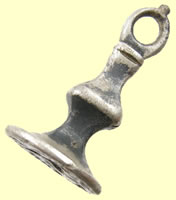 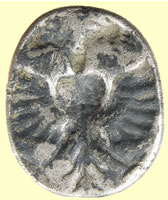
1 silver seal matrix
PAS no: ESS-49C036
Silver seal matrix – double headed eagle with heart
5.02g, 25.09mm L x (13.79mm x 10.98mm seal head) |
Mrs C Beasley-Murray
Essex County Council, County Hall
P.O. Box 11, Chelmsford CM1 1LX
20/02/09
Dear Mrs Beasley-Murray
Treasure Act 1996: 2008 T579, Post Medieval silver seal matrix from the Tendring district, Essex.
Finder: Mary Dodson
On behalf of the Secretary of State for Culture, Media and Sport, I am writing to inform you that the Crown’s interest in this find has been disclaimed.
As anticipated by the Treasure Act 1996 Code of Practice (paragraph 48), it will not normally be necessary in these circumstances to proceed with an inquest. I therefore enclose a copy of the Treasure Receipt for this find, and a copy of the curator’s report, to complete your file.
Please could you contact the owner of the find site, stating that the find is to be returned to the finder, unless objections are submitted within 28 days, in line with paragraphs 48-51 from the Treasure Act 1996 Code of Practice (revised).
I confirm that the find is currently in the care of Laura McLean, Finds Liaison Officer for Essex.
The finder is reminded to keep a copy of this letter with the find, and to advise any purchaser of the find to do the same, as it constitutes formal evidence that the find has been considered under the Treasure Act 1996.
Yours sincerely
Ian Richardson
Treasure Registrar (020 7323 8243)
treasure@thebritishmuseum.ac.uk
cc Mary Dodson (Finder)
Laura McLean (Finds Liaison Officer) |
The find of the week has to be this really nice Roman military buckle found by Min Daryl, he also got a really neat cupid watchwinder.Canadian Rod finished the week off well with two medieval hammered silvers on the last afternoon including a tricky cut 1/4 that I will post later to the latest finds page. 2009 Feb finds.
|
|
| 4thC Roman military buckle - very unusual type with central iron mounting - separate bar for attachment of belt 34.81mm L x 30.76mm |
Georgian watch winder with cupid design |
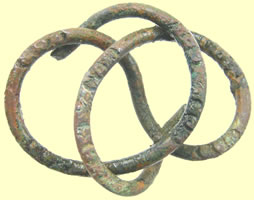
Very interesting twisted brooch - Lombaric style lettering suggests Medieval period
Mark Lehman has sent me the ID below of the Roman silver find
 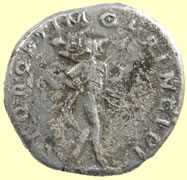
'That's a denarius of Trajan - predecessor of Hadrian (who built a wall up your way - you might have heard of it...) - under whose reign from 98-117 AD. the Roman Empire attained its largest size (briefly, before Hadrian gave Parthia back to the Parthians).
The reverse reads 'S.P.Q.R. OPTIMO PRINCIPI" - a standard reverse legend paired with dozens of reverse types. This one seems to be Mars advancing right. This series dates to about 107 AD. and the obverse legend in its entirety most likely reads IMP TRAIANO AVG GER DAC P M TR P COS V P P.' Mark
|
19th Feb 2008 Great silver finds and skunked on the poorest house in the area - more fixed silver
Large wad of approved export licenses arrived yesterday, list posted on members forum
The guys amazingly got totally skunked on a new field Can Rod had researched where an old house once stood. This was a substantial house in the 1700's but the guys reckon they must have been the poorest family in the area. It shows up clearly on the crop marks but it also appears that a WWII aircraft must have crashed nearby as the area as it was covered with aluminum fragments. Some house sites you win on and some you loose but this one sucked the worse I have ever seen. Rod then went on to redeem himself yesterday with a 5 silver coin day including one of the tiniest silver hammered you can find in mint condition and a rare George II milled silver . Just posted them on the latest finds page 2009 Feb finds.
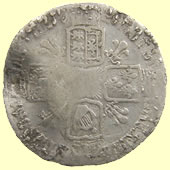 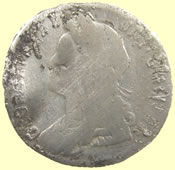
1728 George II milled silver sixpence
I have just finishing 'cooking' Van Brent's silver Roman find from a previous hunt but have lost the before pictures somewhere. This coin turned out mint underneath the crust.
 
Roman silver just 'cooked' sent off for ID 19.2mm, 2.36g
 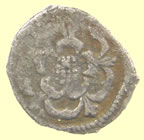 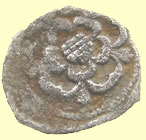
Tiny 1625 Charles 1st hammered silver half penny - rose both sides, no legend type - 10.19mm, 0.32g

Victorian solid silver sugar shaker top - Maker HE & Co
Below is our first silver coin that has fractured during the annealing and straightening process. It was really squashed flat by the plough and any attempt by our goldsmith to silver solder the fracture fails as the silver just flakes away. In fact as you pick it up thin slithers of silver come away from the edge so it is very crispy, real bummer as it is a really great find. This is a good reminder that if you use the goldsmith service there is always a chance that the coin will fail.
  
1199 to 1216 King John of Ireland hammered silver penny
Obv IOHANNES(S) REX
Rev ROBERD - Dublin Mint
More fixed silver coins
   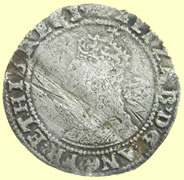
1592 Elizabeth 1st hammered silver 6 pence
 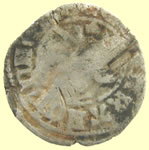 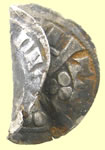 
1341 Edward III hammered silver penny - Florin issue
obv EDWAR ANGL DNS HYB
Rev CIVI/TAS/DVR/ENE - Durham mint
1.13g, 18.13mm
|
17th Feb 2009 Great silver finds - more fixed finds
The guys are hunting more old house sites and finding a great range of silver coins and sizes. The Charles II is the first ever 4 pence we have found and the 1649 Commonwealth is one of the earliest silver love tokens we have also found. I have yet to post 6 more modern milled silver coins bringing the forum competition total to 179 found so far. I have posted a couple more of the fixed members coin finds. See also Coin straightening page.

Size comparison
|
|
1681 Charles II milled silver groat |
1634-5 Charles 1st hammered silver half groat - Tower mint under Charles 1st - Bell mintmark - Type 3a1, no inner circles |
|
|
1593 Elizabeth 1st hammered silver six pence - Tun mintmark 6th issue |
1697 William III milled silver sixpence |
|
|
1649 Commonwealth hammered silver half groat - S shaped love token |
1572 Elizabeth 1st hammered silver penny - Ermine mint mark 4th issue |
  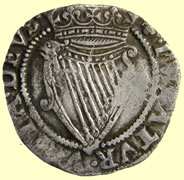 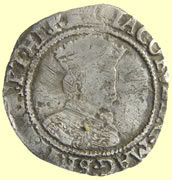
1604-7 James 1st Irish hammered silver sixpence - 2nd issue
obv LACOBUS D.G.MAG BRIT FRA ET HI REX
2.25g, 21.27mm
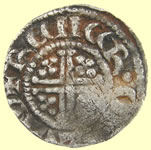 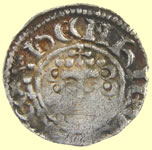 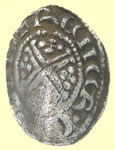 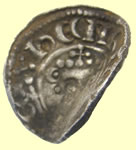
1199 AD King John hammered silver penny - Class 5b2
Obv HENRICVS REX
Obv RENER.ON. LVND
Moneyer Rener - London mint
1.34g, 17.88mm
|
16th Feb 2009 Some great do dads being found
I have another bunch of fixed coins to post later that i picked up from the goldsmith including Cal Vicie's gold guinea find below. This coin is now as straight as a die, great work.
The weather is great out there now and Canadian Rod our club historian took the guys to an old house site he researched on new land. It was covered with hundreds of targets and they spend the day digging loads of coppers, buttons and trash. However amongst the house debris Van brent got two crisp silver coins including this nice Charles II hammered sixpence. Some great do dads found including the Holy Sepulchre badge in bronze and dating somewhere around C13/14th and a really neat toy flintlock. Rod found 3 small 4th Roman bronzes with good detail I will send off to our Roman expert.
I have posted more finds to the latest finds page 2009 Feb finds
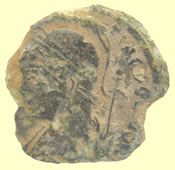 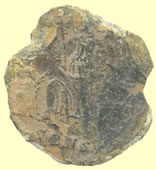
4thC Roman bronze coin sent off for ID
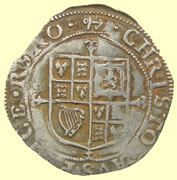 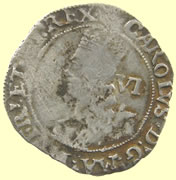
1628 Charles 1st hammered silver sixpence - Anchor mintmark - Group E

Medieval badges Ref Mitchiner p244 939 - 941
 'A badge for a Knight of the Order of the Holy Sepulchre in bronze and dating somewhere around C13/14th possibly very slightly later . This is a very scarce item and it relates to The Equestrian Order of the Holy Sepulchre of Jerusalem being a Catholic chivalric order of Knighthood that traces its roots to Godfrey of Bouillon, principal leader of the First Crusade. According to reliable sources in the Vatican and Jerusalem, it began in historical reality as a mixed clerical and lay confraternity (association) of pilgrims which gradually grew around the most central of the Christian holy places in the Middle East, the Holy Sepulchre or the tomb of Jesus Christ.This would have been a pin for a member of the order , there is a mark on the reverse where the original pin would have been fixed 'A badge for a Knight of the Order of the Holy Sepulchre in bronze and dating somewhere around C13/14th possibly very slightly later . This is a very scarce item and it relates to The Equestrian Order of the Holy Sepulchre of Jerusalem being a Catholic chivalric order of Knighthood that traces its roots to Godfrey of Bouillon, principal leader of the First Crusade. According to reliable sources in the Vatican and Jerusalem, it began in historical reality as a mixed clerical and lay confraternity (association) of pilgrims which gradually grew around the most central of the Christian holy places in the Middle East, the Holy Sepulchre or the tomb of Jesus Christ.This would have been a pin for a member of the order , there is a mark on the reverse where the original pin would have been fixed
|
|
18thC toy flintlock pistol |
1579 Dutch low countries Antwerp hand coin weight - Cornelis Jansen 1564- 1604 4.98g, 15.37mm sq |
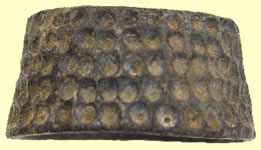 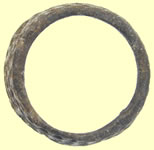 |
|
Medieval bronze open topped thimble (a)21.89mm dia, 6.59g |
16thC copper alloy open topped thimble (b)1.75g,17.8mm dia |
Like a present-day tailor’s thimble, these sewing rings were clearly designed to apply the pressure sideways.
They are also known as open-top or ring-type thimbles, and have complemented their more conventional counterparts from the earliest times. Both the present examples have hand-punched indentations in a spiral pattern, forming five rows on (a) and four on (b). Below the start of the spiral on item (a), there is sometimes a maker’s mark.
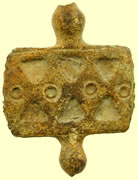 
2nd C Roman plate brooch - 27.39mm H x 21.16mm W
Tenn Brad just sent me a mail as he has the full set of Hattatt's Ancient brooch volumes and I only have the large one. I have asked him to send me a scan.
'oooooh... Equal-ended.Nice and rare. The pin catch terminals are typically on the long ends. Hattatt 1598 or so...Any traces of enamel in those triangles' Brad
 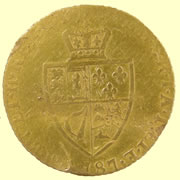 
 
Cal Vicie's repaired gold coin find - 1787 George III milled gold half guinea
|
14th Feb 2009 Weather has been really rough out there but the guys finish on a high
Roman hoard found - 243 coins found
A huge wad of approved export licenses have arrived and the members names have been posted on the forum.
One minute it is sunny, next minute it is raining, but the guys have been finding some really neat relics in the mud. The medieval hammered silver coin below is interesting as it is the first I have seen with a Roman type horn silver 'crust' on it, it is in the 'cooker' to try and remove it. I especially like the lead Napoleonic period lead statue below as it is some kind of large mount. I looked up the hats of Napoleon and Wellington but the badge appears to be a fusiliers type that was used by both the French and British, needs more research.
The guys final afternoon finished on a high with 3 medieval hammered silver pennies and a 12thC bronze beehive thimble which I will photo later. The guys left this morning having had an exceptional week in relic terms after some of the worse hunting conditions I have seen in 6 years. The new crew arrives this morning and it is bright sunny day out there, hope it continues.
I have posted a few a load more do dads to the latest finds page and will upload more later.2009 Feb finds
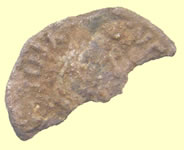 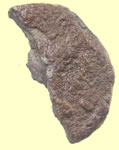 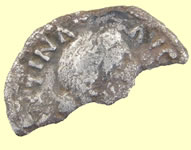 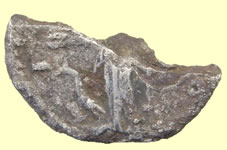
'Cooked' Roman silver from earlier in the week
Could be Annia Galeria Faustina, more familiarly referred to as Faustina the Elder (Latin: Faustina Major; born September 21 about 100, died 141), was a Roman Empress and wife of Roman Emperor Antoninus Pius. - Sent for further ID
 
Medieval silver long cross penny in the 'cooker' to remove the horn silver crust
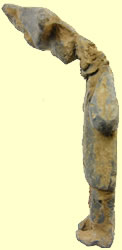 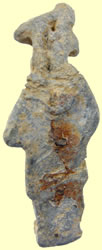 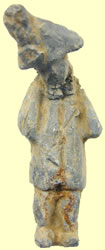 
Great find, early Napoleonic lead statue mount -found on a French Napoleonic POW site - 74mm H
The hat shows the symbol of a fusiliers

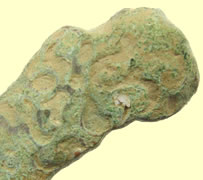  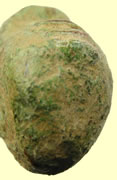
16th C Tudor decorated knife handle - 83.7mm L
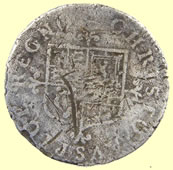 
1670 's Charles II milled silver four pence - undated type
|
11th Feb 2009 Festering weather - Great Saxon finds
The guys are doing really well this week considering the festering wet weather out there and having to hunt limited stubble fields. This morning it was bright sunshine and warm and then it chucked it down again in the afternoon. All the guys this week are returning members and I am very impressed with the guys skill to be able to pull out tiny hammered medieval silver in some of the worse muddy conditions I have seen. Orv took a great picture of Minnesota Mindy below at lunchtime, 1/4 pounder with cheese and fried onions firmly in hand. She is a mega hard core senior female member and out there swing for swing with the guys and getting down and dirty, she even found a cut qtr medieval silver penny in the mud , impressive.

I have posted a bunch more finds onto the latest hunt page 2009 Feb finds. Some impressive Saxon period finds coming up including our first ever Saxon strap distributor, we have several Saxon harness cheek pieces but not the distributor part.
I sent a picture of the wrist band off to the museum yesterday to see if they have seen this type before with the circular punched design, what neat relic.
  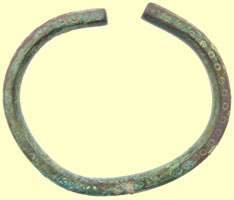
Saxon wrist band with punched circle design - 63.87mm W x 4.92mm T
 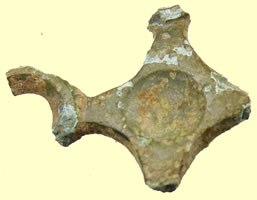
c 10thC Saxon harness strap distributor
  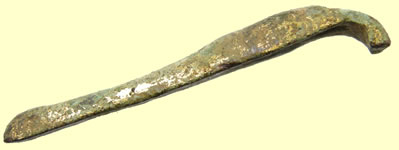
Saxon gilded and decorated hanger
  
Stunning 17thC decorated hooked sword hanger
|
9th Feb 2009 Pickings are slim - posted more finds
Pickings were really slim yesterday although a new field was covered with tons of targets. Most of it was trash but Idaho Jerry and Daryl saved the day with a couple of nice silvers. Daryl is using the new E Trac and it continues to be very impressive with this is his 3rd tiny silver of the week so far. The silver Roman found yesterday is now in the 'cooker' to remove the thick crust that grows on early Roman's. In the picture below where the coin is fractured you can see the thick crust clearly. I have posted more finds to the latest finds page.2009 Feb finds
 
Roman silver coin fragment - 'cooking' it to remove 'hornsilver' crust
 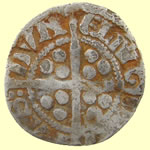 
Very interesting hammered silver penny - 17.36mm, 1.06g
1341 AD Edward III florin type CIVI/TAS/DVN/ELN - Durham mint - note the crozier to one limb of cross in inset (after ELN)
Obv EDWAR ANGL DNS HYB
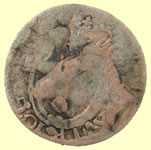 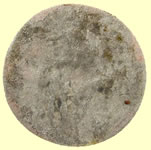
Interesting small foreign silver coin with a copper tinge 16.71mm,0.42g - need to check World coin book
Obv GIA DVX.FIRIO.G****
   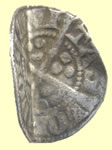
Straightened 1279 Edward 1st hammered silver penny - Cross potent Class 1d
obv EDWR ANGL DNS HYB
Rev CIVI/TAS/LON/DON - London mint
1.23g, 18.82mm
|
8th Feb 2009 First hammered silver
Orv thought he had found a rough old Elizabeth penny in the dark but when he washed it up he suprised to have found one of the tinest hammered coins there are, an Edward II 1/4 penny in superb shape. Ohio Scott made an amazing couple of early copper finds in the same area, two 1674 Charles II farthings. These are real hard to find in any kind of legible condition and he got two with the dates showing next to each other.
 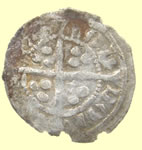 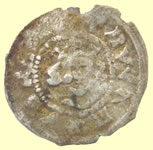
Tiny 1307 Edward II hammered silver farthing (1/4 pence) Type 28 - 12.44mm, 0.29g
Ob EDWARDVS REX
Rev CIVI/TAS/LON/DON - London mint
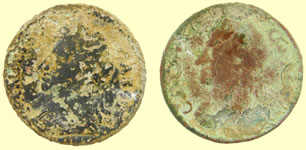 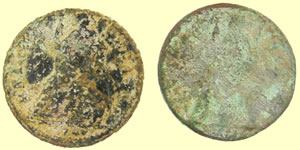
2- 1674 Charles II milled copper farthings |
7th Feb 2009 First hammered silver
Some great bits and pieces turning up including our first hammered silver coins of the season. Min Daryl has swapped his old machine for the new E Trac and found two really crisp coins, Venetian Soldino and a mint Commonwealth penny. Min Mindy pulled up our first ever cut 1/4 Henry II Tealby coin and a rough Elizabeth 1st six pence. I have started a new hunt page and uploaded more finds to the page. 2009 Febfinds including a couple of really crisp 17thC hammered copper trade farthing. Trade farthings.
I have updated the forum competition page with the latest milled silver count.
|
|
Stunning 1649 Commonwealth hammered silver penny |
(1501-1521).
Venetian Soldino hammered silver coin 0.26g,12.08mm
Rev: LAVS TIBI SOLI (Thee Alone be Praised). Haloed figure of Christ holding a cross.
Obv: LE LAV DVX S M V (Leonardo Lauredan, Doge. St Mark of Venice.) Doge kneeling before Saint Mark. |
|
|
1158- 1180 Henry II Tealby cross and crosslets hammered silver cut qtr penny |
17th hammered copper trade farthing - Daniel Walker of Woodbridge Suffolk - Grocer |
| |
|
| |
|
|
6th Feb 2009 Guys first day back - nice relics
Hunts are finally underway again but the ground has been very wet. The guys therefore picked a grass field near one of our new Roman areas that we have never hunted. It produced some interesting finds including a really chunky C 10thC Saxon harness check piece found by Min Mindy, two Roman bronzes with some detail and a bottom fragment of would have been a spectacular Roman enameled head stud type fibula brooch. The guys found 4 late milled silver including 2 large silver florins (24 pence) and the usual, copper and buttons etc . I will start a new hunt page and start uploading more finds shortly.
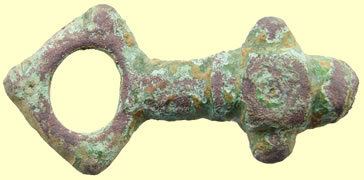
 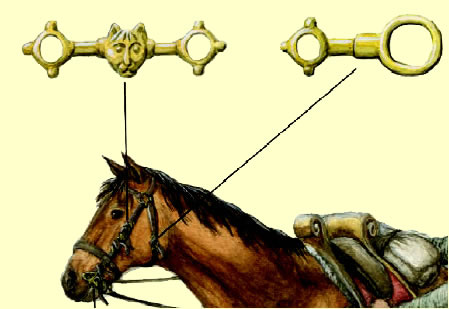
Incomplete
harness strap distributor (probably a bridle cheek piece) of the late
Anglo-Saxon to early Norman period
 
ROMAN (Certain) to ROMAN (Certain), Circa 75 AD - Circa 200 AD bottom part of the same type of enameled brooch below found earlier in the season

ROMAN (Certain) to ROMAN (Certain), Circa 75 AD - Circa 200 AD
| Object Type: |
Head stud Brooch |
 |
Incomplete copper alloy ‘Roman ‘head stud’ brooch. What survives is the upper part only. The wings are semi-cylindrical, short and one wing is truncated. The spring fixing lug is broken, the spring and pin are entirely missing. A small worn knop to the top of the brooch is probably the remains of a chain loop fitting. On the head of the brooch is a worn, raised stud formed of two concentric circles. This may once have been enamelled, though no traces survive. On the surviving portion of the bow are two vertically placed recessed squares, the upper contains red enamel, the lower is empty. These squares presumably continued down the bow. The lower half of the brooch is missing, along with the catchplate. No original surface survives. Exposed surfaces are mid and light green. The broken edges, though not fresh, are not well worn, suggesting damaged occurred in the more recent past. The width of the wings is 20.48mm, the bow is 10.78wide, the brooch is 28.95mm long and weighs 10.68g. Brooches of this type date from about AD 75 to AD 200. Examples can be seein in Hattatt, 1987, Brooches of antiquity, page 123, figure 41. |
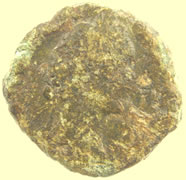 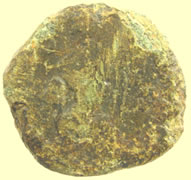
1st/2ndC Roman bronze sent for ID 29.47mm, 15.03g
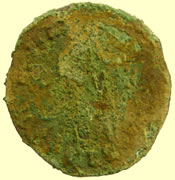 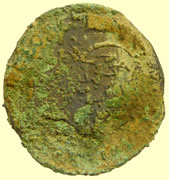
3rd/4th C Roman bronze sent for ID 26.44m, 4.89g
|
1st Feb 2009 4 more days to go - Awards and Prizes
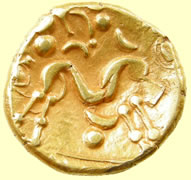 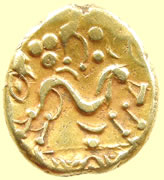
Gold page
Excitement on the members forum is building as we near the kick off to the 2nd half of the season. It is great to start a month earlier this season as the land conditions are just perfect out there, tiny green shoots on pool table flat fields. I went for a drive to see a couple of our farmers and their land is in stunning condition so the coil can be flat on the deck. We still have lots of virginal sites to hotspot and our old ancient lands have compressed nicely over the holiday break. As day light is shorter this time of year we are going with the earlier start time and will be on the fields by 7am, all the guys are coming equipped with night lights if they want to continue to late. Orv and Mindy who are here the first week get to take their Celtic gold coins finds home they found in the first half of the season as their exports were approved. The current gold total for the half season is on par with other seasons and stands at 13 pieces.
Special thanks to all the members for there continued support on the forum keeping it light hearted and fun during the break. Hopefully the first team can get the juices flowing with some more great finds.
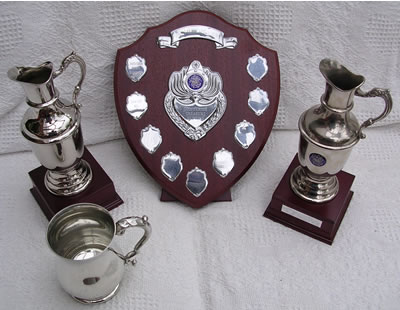
Remember if you want to take the new fun 'History Heathen' pub quiz then let me know - Cal Jim is currently in the lead and winning the free trip with a score of 32 out of 50 questions answered correctly .
Atlanta Mike is currently winning the 'Coin hunter of the year' award with a superb total.
Guys have yet to vote for the 'find of the year' but there are some clear monster finds in the running to win.
Both the Wayne Otto and Canadian Greg memorial awards will be decided on in April.
Free forum competition to guess the number of milled found this season stands at 158 and Ark Mary is in the lead. Prize is a free trip and you can check your guesses at that link.
More fixed members coins posted on the coin straightening page
  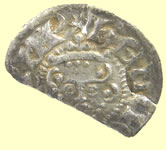 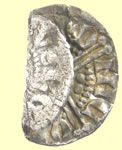
1247 Henry III hammered silver voided long cross - Type IIIa
Moneyer Nicole of London
  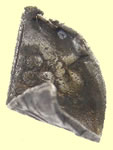 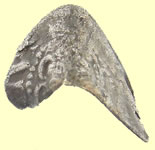
1247 Henry III hammered silver voided long cross half penny
0.62g
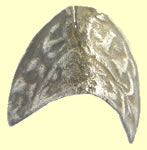 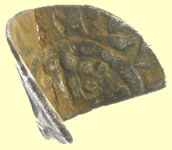 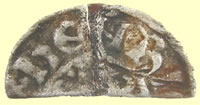 
1217 Henry III hammered silver short cross 1/2 penny - class 6b2
Moneyer Pieres of London
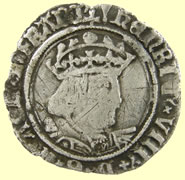 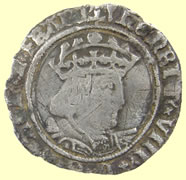 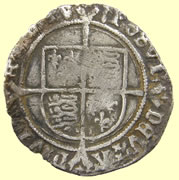 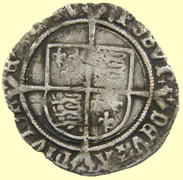
1533-42 Henry VIII hammered silver groat - arrow mintmark
|
31st Jan 2009 More unpublished finds and fixed coins
I have just about finished uploading the last of the unpublished finds out of the export pouches. There is a very interesting widget which appears to be a kind of Roman protected loop terret but feels more medieval. Luckily I am dropping the last of the finds for recording and ID to the museum next week so I will include it in the bag. A couple of really rare finds include our first ever Commonwealth period trade weight and a medieval spur with only 4 spikes which is not in my ref books.
|
|
|
Medieval spur rowel - not seen this type in ref books with only 4 spikes - one for the museum |
17thC lead trade token - EF |
1649 Commonwealth trade weight - Crown shield cipher
First one of this period we have found
|
|
|
Interesting very thick copper 1820 Denmark Skilling Species
Can't find it in the World coin books - any idea ?
|
Above average condition 1670 Charles II copper farthing |
|
Fascinating piece - concaved copper alloy 61.14mm W x 32.89mm H . It kind of feels like a Roman terret type arrangement or even one of those Medieval bucket type handles with a broken loop - one for the museum |
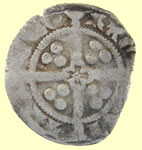  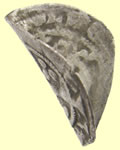 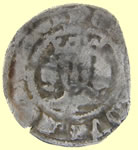
1464/5 Edward IV hammered silver penny - Type VIIi - 0.93g, 18.07mm
obv EDWARD DI GRA RE ANGL
Rev CIVI/TAS/EBO/RACI - York Mint - Archiepiscopal issue
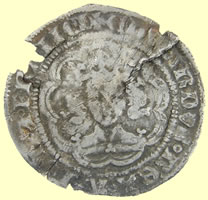 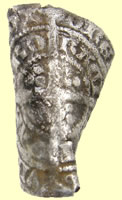 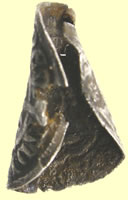 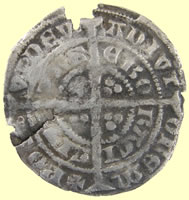
1356-61 Edward III hammered silver groat - Initial cross 3
Needs straightening to decide on the type
rev CIVI/TAS/EBO/RACI York mint
22.24mm, 1.73g
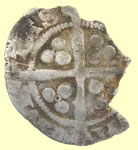 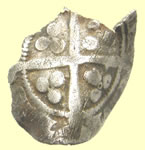 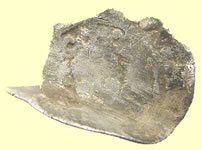 
1352-53 Edward III hammered silver penny - pre treat period series D - annulets in all 4 qtrs on obv
Ov *DWAR
Rev CIVI/TAS/***/*ON- London minttype
|
30th Jan 2008 More great repairs - exports completed
All export applications have been made for the first half of the season and you should all have your word documents e-mailed to you over the next couple of days with detailed finds lists and coloured pictures of all your finds. Special thanks to the guys at export duty for their exceptionally fast turnaround time with application approval. The new procedure of annotating those finds due to go into the museum is working really well.
Penn Christies silver annular brooch was reported as treasure but eventually disclaimed by the British Museum and returned to her. It is our first trial of an artefact being repaired and what a stonking job he made of it and he even cleaned it for us !! I have updated the coinstraightening page with the latest fixed items and a huge 1549 -51 Edward VI hammered silver shilling which in one piece would have been a monster find.
 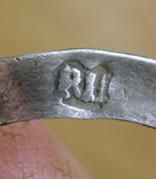 
Penn Christies annular silver brooch repaired and he even cleaned it !
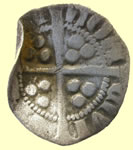 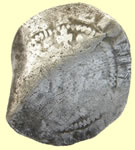  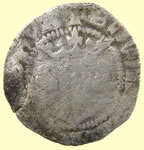
Edward III 1344-51 hammered silver florin penny
Obv EDWAR ANGL DNS HYB
Rev CIVI/TAS/LON/DON - London mint
16.74mm, 0.99g
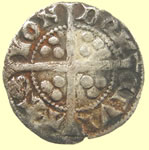 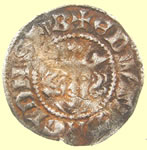 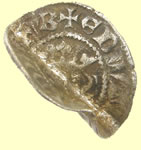 
1279 Edward 1st hammered silver florin penny -class 10cf3
Obv EDWAR ANGL DNS HYB
Rev CIVI/TAS/LON/DON - London mint
1.35g, 18.25mm
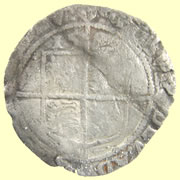  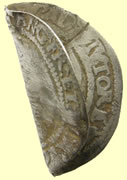 
1570 Elizabeth 1st hammered silver 6 pence - castle mint mark
  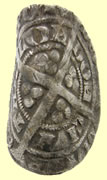 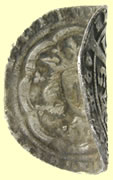
1351-2 Edward III hammered silver groat (4 pence) Inital mark
Cross 1 - 4.43g,25.69mm
obv EDWARD DIV REX ** HYB
rev CIVI/TAS/LON/DON - London mint
 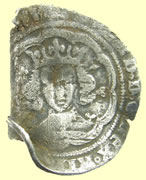 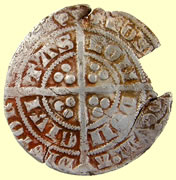 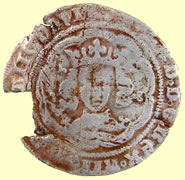
1351-1361 Edward III hammered silver groat (4 pence) - pre treaty 3rd coinage
obv ****RD.D.G.REX ANGL Z FRANC HYB
Rev CIVI/TAS/LON/DON - London mint
26.29mm, 4.26g
|
29th Jan 2008 Coins back from repair - more finds and updates
I picked up 35 of the guys repaired coin finds today from our goldsmith and he has done a remarkable job again. I have posted a couple below as an example and I will post the rest as I clean them up and re- photo them. However our first two ever coins broke during the annealing and straightening process, an Irish Edward 1st and a Medieval short cross penny. Both of these coins were folded and squashed flat and unfortunately are of a very low silver content type. We discussed the way forward to repairing them and because the folded edge is concave he will file the edge flat and silver solder the two halves together. It will be interesting to see the results of this technique as we have success in the past joining a tiny broken medieval cut half penny.
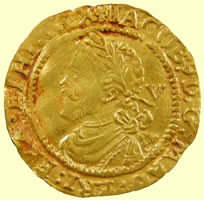   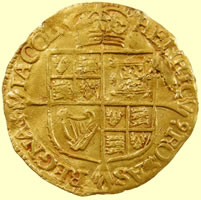 
1619 -25 James 1st hammered gold Quarter-laurel - 2.24g, 19.46mm 2nd coinage
 = =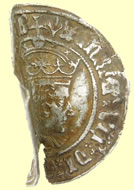  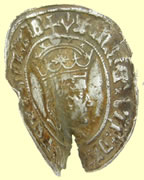 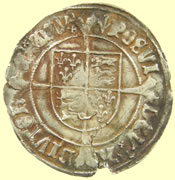 
1507-9 Henry VII Regular profile issue hammered silver groat - Triple banded crown - Pheon initial mark
2.90g, 27.51mm
Obv HENRIC VII DI GRA REX ANGL Z FRA
Rev POSUI DEUM ADIUTO(R)E MEU(M)
   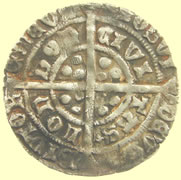 
1472 Edward IV hammered silver groat Type 10 , initial mark sun both sides, trefoils by neck, long cross fitchee
obv EDWARD DIA.REX.ANGL.Z.FRANC
Rev CIVI/TAS/LON/DON - London mint
25.18mm, 2.79g
|
|
|
|
Local government button ?
Tibson & Newby
Birmingham
|
USA |
Metropolitan Steamship Cº |
In use 1866 - 1911 |
Ship's Officer Button |
MSSC
W.Jackson & Co London
58 Gracechurch St |
Unrecorded Royal Artillery button
'Harwich' |
Royal Corp of Engineers
1911 - 1935 |
Uploading Georgian military artefacts to our foundintheground database
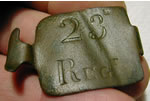  
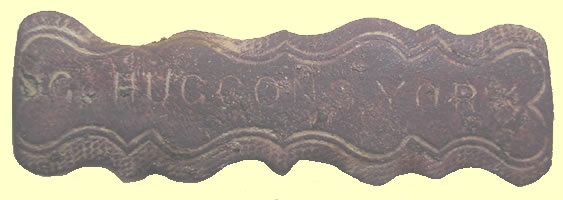
|
27th Jan 2009 PC died for a few days - sorted out the library - ordering books
Just over a week now to the start of the 2nd half of the season.
I have been offline for a few days as my main PC power supply suddenly died. I was able to use my laptop for answering e-mail etc but it is not up to the job of updating our site. It is now fixed so I can get on with more exports and updates. I took the spare time to sort out our reference library as those last 13 volumes we bough have literally pushed it off the edge. I went and saw a local pine company who making us up a large made to measure bookcase that will fit all the large volumes perfectly, should be here in a few days. I have also been reading through some of the fascinating information contained with these new books and guys have shown interest in buying a set as they are such fantastic value. Senior member Tenn Brad, who has just started his degree in Archeology at Leicester University, having been sponsored by our club has asked me to ship him a full set. They are far too heavy to mail so I have bought another spare set for him to take home on the plane after his next hunt. The Archeology trust that stocks these books is only a 15 minute drive away from my house so they are easy to pick up. If you would also like a set then drop me a mail and I will have it ready for collection by you on your next trip.

|
23rd Jan 2008 More exports and finds - pound drops again to 1.36
Canadian Rod our club historian is currently updating the laminated master map with all the new land ready for the start of the 2nd half of the season. He has also been researching the new land and found some remarkable features including another recorded medieval fair and a Roman villa. The map will be available to view shortly.
More exports licenses arrived approved yesterday so most of the guys returning in the 2nd half of the season can now take their export pouches home. I have another meeting with the museum in 2 weeks to drop off more finds for recording and further analysis and pick up the ones that have so far been recorded on to the PAS database. There might be an element that will still with the museum or with the coin straighteners, so take home the bulk of your exports and send me back you export license and I will post those few back by surface mail when they are ready.
Mass Bruce had a great collection of 18thC Royal artillery buttons in his export pouch and an unrecorded early 28th regiment of foot , Colchester has been a garrison town since the Romans and the area we hunt has had amazing amount of military activity. I have updated Army numbered regiment page on the site. Numbered regiments
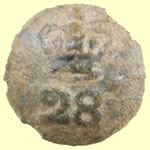
Early one piece 28th Regiment of foot pewter button- not in ref books or Troiana
Some how I missed recording his really early coin weight on our coin weight page - just updated it now
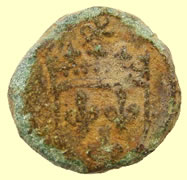 
1422- 61 Bronze uniface Crowned Three lis in shield French Ecu gold coin weight. No Letters by the shield indicate English version.

Nice group of one piece 18thC Royal Artillery buttons
This is an interesting piece below I have been researching which I initially thought was a Roman latch key with the broken loop on the end. I have however found the exact type recorded in CAR report volume 5 Fig 66; 2989 as a Roman to post Roman balance (scale with beam arms of equal length). The arm has the same punched dots clearly visible on Mass Bruce's find.
'The lack of any marks to separate the punched dots into groups probably indicates that each dot represents one pound, thus making it impossible to distinguish between Roman and post Roman weights'


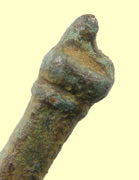 
Roman balance arm - punched markings along stem -103.46 mm L
Another interesting find is this silver decorated clog fastener hallmarked with the makers name and George II bust duty paid impression.
 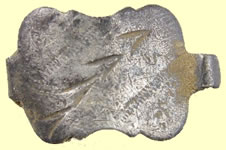
18thC silver decorated clog fastener maker WI WW -Wakely & Wheeler London - George II duty paid bust
|
19th Jan 2009 More finds - Huge Celtic gold hoard found - Pounds drops to 1.38 to the dollar
This world recession is certainly a bonus to hunting here as the dollar hit another all time high now today at 1.38 to the pound. As we are priced in pounds this makes us the cheapest detecting tour in the world now and over $800 to $1000 cheaper per week than the other UK tours. The Canadian dollar is only 1.75 and the Euro 1.07 which makes us 30% cheaper than last season. Buy them pounds now and make a killing on a trip. Slots are running out fast so check out what's left on this page. http://www.essexfarmholidays.co.uk/fullboard.htm. Remember you can book and pay for your trip now for next season and take full advantage of the ridiculously low exchange rate and cheap airfares.
A huge Celtic gold coin hoard has been found locally here but unfortunately not by us, what an amazing find. It certainly gets the juices following for the start of the hunts on the 5th Feb. We have found several Celtic gold hoards here but not in that magnitude.

One of the UK's largest hauls of Iron Age gold coins has been found in Suffolk.
The 824 so-called staters were found in a broken pottery jar, click here for full story
I have just posted more export find lists and pictures on the members forum and updated the club records page with 2 new entries. This is the page of the oldest, largest, biggest etc found by the club Records Page
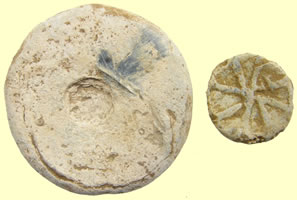
GA Harry had a couple of nice bonus lead finds in his export pouch. The trade weight is a Henry VII or VIII with the crown hallmark (Ref Rogers) dating to around 1509 - 1547 AD, next to it is his 15th C lead token find. He also had this neat 18thC winged barrel key complete and unbroken.
 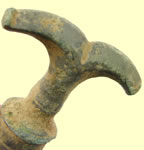
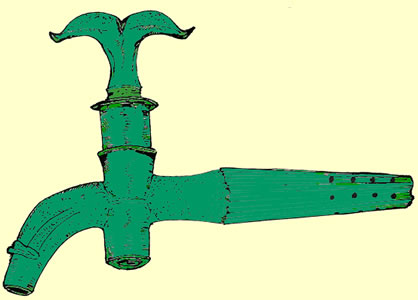
We record every Roman coin found here including the 'grots' as there is a project at the museum to plot the spread of Roman coins found in Essex. The one below was found by Chicago Ron and this is how they are recorded on the PAS database.

PAS database Ref ESS-FA7CA4
| Object Type: |
Coin |
 |
Roman copper alloy coin; Nummus of Valens (possibly) |
| Coin-specific information |
 Denomination: Denomination: |
nummus (AE 1 - AE 4) |
 Denomination Qualifier: Denomination Qualifier: |
Certain |
 Ruler: Ruler: |
Valens (Roman: 364-378 ) |
 Ruler Qualifier: Ruler Qualifier: |
Possibly |
 Reece Period: Reece Period: |
19 |
 Status: Status: |
Regular |
 Status Qualifier: Status Qualifier: |
Certain |
 Obverse Description: Obverse Description: |
Diadem bust facing right |
 Obverse Inscription: Obverse Inscription: |
DN [?VALENS PF AVG] |
 Reverse Description: Reverse Description: |
Unclear figure - ?Victory advancing left |
 Reverse Inscription: Reverse Inscription: |
Illegible |
 Reverse Mintmark: Reverse Mintmark: |
Illegible |
 Degree of wear: Degree of wear: |
Worn: fine |
 Die Axis Measurement: Die Axis Measurement: |
12 o'clock |
 Die Axis Certainty: Die Axis Certainty: |
Certain |
|
17th Jan 2009 Halved this news page - more updates
I have halved the size of this quick news page to improve loading times, the extended full news page is still at Full news.
I have been updating the award and prizes page with latest pics of awards up for grabs this year and last years winners pictures.
A huge wad of 19 approved export license arrived this morning, finders list posted on members forum. Here are two more of our latest finds entered onto the national PAS database. Both were found by Chicago Ron on a new Roman area he and his team discovered in the first half of the season on new land.

Pas entry ESS-FBA194
LATE IRON AGE (Certain) to ROMAN (Certain), Circa 1 AD - Circa 200 AD
| Object Type: |
COSMETIC MORTAR |
 |
Incomplete Roman copper alloy cosmetic mortar. The mortar is crescent shaped in profile and V-shaped in section as it is hollow. There is a globular knop to one end, whilst the opposite end is damaged and truncated. To the underneath of the object are two slight knops which are all that remain of the suspension loop. The original surface is missing and exposed surfaces are much abraded. They are light green in colour. Damaged edges are worn, suggesting damaged occurred in antiquity. The mortar is 51.85mm long, 9.75mm wide, 12.78mm high and weighs 12.01g. The mortar is Late iron to Roman in date, c. AD 1-200. |

PAs ref ESS-FB7F44
ROMAN (Certain) to ROMAN (Certain), Circa 75 AD - Circa 200 AD
| Object Type: |
Head stud Brooch |
 |
Incomplete copper alloy ‘Roman ‘head stud’ brooch. What survives is the upper part only. The wings are semi-cylindrical, short and one wing is truncated. The spring fixing lug is broken, the spring and pin are entirely missing. A small worn knop to the top of the brooch is probably the remains of a chain loop fitting. On the head of the brooch is a worn, raised stud formed of two concentric circles. This may once have been enamelled, though no traces survive. On the surviving portion of the bow are two vertically placed recessed squares, the upper contains red enamel, the lower is empty. These squares presumably continued down the bow. The lower half of the brooch is missing, along with the catchplate. No original surface survives. Exposed surfaces are mid and light green. The broken edges, though not fresh, are not well worn, suggesting damaged occurred in the more recent past. The width of the wings is 20.48mm, the bow is 10.78wide, the brooch is 28.95mm long and weighs 10.68g. Brooches of this type date from about AD 75 to AD 200. Examples can be seein in Hattatt, 1987, Brooches of antiquity, page 123, figure 41. |
|
15th Jan 2009 Museum meeting and ID's - more books - PAS find entries
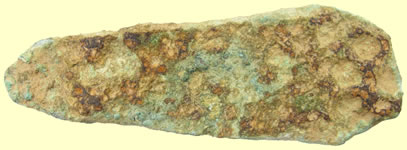


I had a meeting yesterday with the museum to drop off another large batch of finds for recording and further ID. I was lucky that their Bronze age expert was around to look at Canadian Victor's 2000 BC flat axe find. The axe is very small in comparison to the one found by Van Brent and I thought it might be a chisel. Their experts suggests that it is a votive offering or a miniature axe for perhaps ceremonial use of that period 2000 BC, it will probably go off to the experts at the British museum for their views, great find.
 
The FLO at the museum has seen a complete example of this spoon with the crude etched face and it was dated as 1400's AD which is a great early spoon.
 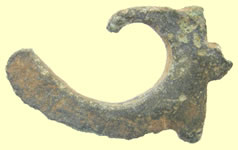 
The FLO also ID'd what I thought was a Roman reigns guide as a late Roman period buckle, half the buckle is missing.
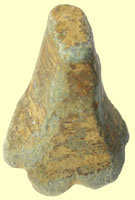 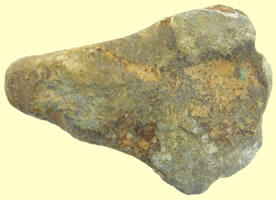
This Roman pot foot was confirmed as Roman and a drawing exists within a set of Roman 'Finds from Colchester' Volumes the museum has. They are brilliant ref books so I drove to the Colchester Archaeological Trust this morning and picked up the 13 books in the set. I have not seen these advertised in any of the book shops I use so here is a link if you want a copy. They cover every aspect from pottery, glass, bones, relics, coins from Roman through Anglo Saxon. They are tremendous value at only £160 for the set direct from them. http://www.catuk.org/ click on Archaeology reports

Some more light reading for bed time !!
This cut 1/4 hammered was lurking in Vegas Jack's export pouch and is badly debased silver and will not clean up. Luckily it has the part legend RIO which only appears on the reverse of voided long cross pennies of Henry III, On the obverse you can see VS R which is part the legend HENRICVS REX. This is a man in tune with his machine to make this tiny find.
 
1247 Henry III voided long cross hammered silver cut 1/4 penny
RIO - hE(NRI - hE(N/RIO/NLV/NDE - Moneyer Henry of London Mint
I have the PAS printouts of all our recent finds that have been recorded on the national database. The fibula brooch is an important ID as we have found several in the past and they are casting failers. I will post a load more entries during the week.

PAS entry ESS-FB16B5
LATE IRON AGE (Certain) to EARLY ROMAN (Certain), Circa 20 AD - Circa 50 AD
| Object Type: |
Colchester type One piece Brooch |
 |
Incomplete copper alloy, one piece ‘Colchester’ type late Iron Age to early Roman brooch. Both wings of the brooch are truncated. The forward facing hook is truncated and worn. Behind the head of the brooch the short backward hook is also truncated and worn and the integral pin coil and shaft are entirely missing. The bow is sub circular in section. It is complete and ends in a blunt point. The catch plate is entirely missing. The brooch is abraded and nothing of the original surface survives. Exposed surfaces are light green. The break edges are worn smooth suggesting damage occurred in antiquity. The width of the wings is 8.7mm. The bow is 3.91mm wide at the broadest point. The brooch is 27.65mm long and weighs 1.69grams. Brooches of this type date from 20-50AD. An example can be seen in Crummy 1983, The Roman small finds from excavations in Colchester, figure 6, number 38. |

ESS-FED0E7
MEDIEVAL (Certain) to MEDIEVAL (Certain), Circa 1200 AD - Circa 1400 AD
| Object Type: |
Shield-Shaped Mount |
 |
Complete, cast copper alloy, medieval, shield shape mount with hook. The upper part of the object is formed by the shield-shaped mount that is decorated to each side with a white enamelled swan advancing left. There are tiny traces of gilt in the surrounding field. At the pointed end of the shield is an integral sub square collar, also with traces of gilt. From beneath this extends an integral, vertical hook, with a short, shallow hooked end. The original surface is missing and exposed surfaces are light green. The purpose of this object is unknown, though the shield is clearly meant to be viewed vertically. A good parallel can be found in Griffiths, 1989, Shield-shaped mounts, Finds Research Group 700-1700 Data sheet 12, page 4, number 14. It is 13th or 14th century in date. The object has a total length of 61.33mm and weighs 19.6g. the shield mount is 21.42mm wide and 25.31mm long. The collar is 12.41mm wide and 11.47mm thick. The hook portion is 30.23mm long. |
|
13th Jan 2009 'Lead is your friend' - more approved exports
I have just posted more approved export licenses received this morning onto the members forum.
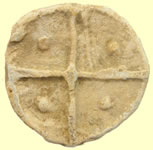 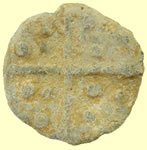 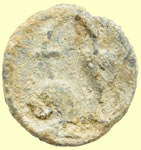 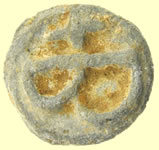 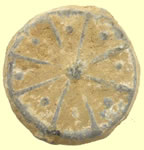
Various lead token finds this season
We have a saying here that 'lead is your friend' as it might be a pain in the butt to dig obscure chunks but so many great finds are made of lead like Pilgrims items, weights, lead shot, early tokens etc. I have just completed Ark Gary's export pouch and originally I thought this was a lead prism standing weight but it is a 1/2 pound Medieval lead shield weight with three prancing lion symbols on it. The David Rogers lead weight book shows has an exact match Page 37 Fig 86 - Three Lions passant guardant to the right in a border with bezant above. What a great find. This is only our 2nd ever lead shield weight we have found, the first one was found by Cal Jim on the same new site we just started searching this season.

Medieval lead shied weight - Lion facing left
His Medieval lead token find is based on the long cross hammered silver pennies of the period and this example has three pellets in each quadrant exactly like an Edward 1st penny Circa 13th C. This is a type 2 using the Powell 32 classification system for lead tokens.

Medieval shield 1/2 pound lead weight-48.3mm W x 56.09 mm H x 13.69mm L next to a Medieval lead token - long cross and pellet Type 2

Roman lead slingshot and medieval lead plumbob
I have just uploaded more complete find lists and export pictures onto the members forum

1**. Roman bronze coin Trajan Sestertius (98-117 AD)
2. Henry VI 1422-27 Hammered silver half groat - Calais mint - Annulet issue
3. 1922 George V milled silver sixpence
4. Edward III 1344-51 hammered silver florin penny
5. 1727 George II milled silver sixpence – love token
6. 1696 William III milled silver sixpence
7. 1582-4 Elizabeth 1st hammered silver penny - A mintmark 6th issue
8. Edward III 1344-51 hammered silver florin penny
9. 1561 Elizabeth 1st hammered silver three pence - Pheon mintmark
10. 1427-30 Henry VI hammered silver groat - Rosette Mascle issue
11. 1572-3 Elizabeth 1st hammered silver half groat - Lis mintmark 4th issue
12. 1634 Charles 1st hammered copper rose farthing
13. Post 1709 silver button
14 **. C10thC Saxon key with broken suspension loop
16. 1865 Victorian milled silver shilling
17. Spanish 1786 Charles IIII milled silver reale
18. 1696 William III milled silver sixpences
19. 1696 William III worn milled silver shilling
20. 1696 William III milled silver shilling
|
11th Jan 2009 ID help and foundintheground forums - more unpublished finds
I keep getting dozens of e-mail from guys wanting help with find ID's by e-mail. I never open attachments due to all the viruses going around so unless you post them on the foundintheground forums I cannot answer your questions. Foundintheground.com is our finds database and a forum to log all our outstanding unknowns. If you can ID any of the outstanding finds then you win a free finds tray http://foundintheground.com/. There are multiple forums for all the different type of finds for ID from Military buttons to Roman.
 Marianchem just posted a really neat find from Serbia on the forum thinking it was Roman. It is in fact a 16thC Tudor period pin and amazingly in one piece. We have found two pin heads of that style which were sent to the British museum as treasure, they were dated as 16thC. Marianchem just posted a really neat find from Serbia on the forum thinking it was Roman. It is in fact a 16thC Tudor period pin and amazingly in one piece. We have found two pin heads of that style which were sent to the British museum as treasure, they were dated as 16thC.
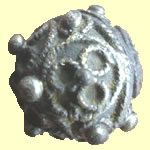 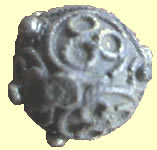
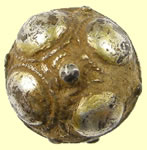 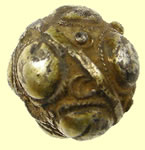
If you have not received a reply to any mail then post your find on our ID forums and we will try and help you.
More unpublished finds below from the export pouches.
|
|
Interesting, I just noticed that this find (left) from PA Jeff's export pouch matches a find earlier in the season. Both are of similar design and show wear to the inner face. I already have the first one bagged up to drop off to the museum this week so I will take along both for their views. I have feeling that they are reigns guides showing traces of iron inserts to screw into wood. |
|
Unusual Roman period pot foot |
|
|
Unusual Georgian bowl leg and foot |
19thC coin weight with London Guildhall and Ewer hallmarks |
|
|
|
|
Capt / Commander - 1774-1787
Back Mark - G Turner, St Martins Lane |
19thc Great Eastern railway and steamship company button |
Great shape 18thC Royal Artillery button
Officer & O/R's - 1790-1802 |
|
George Rex button GR
Back mark Firmin & Co London - Early 19thC |
|
10th Jan 2009 First exports back - Serious hard core hunt for Nov 09
The clock is ticking down for the start of the season and I still have a dozen or so exports to complete yet, I will just get them finshed and it is time to start all over again ! I have already received the first batch of the approved export licenses and I have posted the names on the members forum. We have lots of interesting new areas to explore in the 2nd half of the season including two potentially really exciting Roman sites, members are getting well stoked.
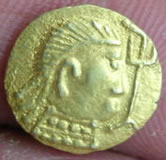 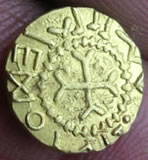
Louisiana Sal (mudslideslim) is planning his next trip and is one of our 'hard core' breed of detectorists that come here. He has booked the week 16th Nov to 23rd Nov 2009 and is going to run a serious hard core Barn hunt next season. He just dropped me a mail with the details and has a couple of free slots. Check out Sal's unique finds from the field video's. Also check out his own detecting video web site http://treasureoutfitters.com/. Drop Sal an e-mail for more info. You must be HARDCORE to join this hunt as there will be no finishing early. However you can always take a day off and stay in the Barn and soak in the hot tub !!
.jpg) .jpg) .jpg)
Fellow Hardcore Hunters,
The hunt is set for next year and y'all are invited. This promises to be a HARDCORE 12 hour detecting day relic hunt on the ancient fields of England. I had a great hunt this time and was able to bring home my 640 AD Saxon gold coin, too! After doing this for two years, I have a good feel for the area and have kept detailed records of where the good finds have been made. All fields are regularly deep ploughed and rolled flat each season. Each trip has been around this time of year and the weather has been mild with many fields freshly available, plowed, rolled and well compacted. Y'all take some time to think on it and let me know. Drop me a mail if you are serious hard core.
Details are as follows:
Date: November 16-23, 2009
Detecting Time: 6.5 Days X 12 = approx. 78 hours (this is no joke - we will hunt from sun up until 8-9pm every full day and from 1pm-8pm on the half day.)
Room: 7 bed 5-star barn house - with all the amenities including large hot tub for after a hard day of diggin!
Food: 3 meals a day included
Transportation: all included
Hunt Fees on over 250 large fields: included
Price: approx $1225 for the week (exchange rate varies)
Exportation Submission and Processing: Included
Airfare: Not included
Later,
Sal |
|
9th Jan 2009 Repairs to coins and ring brooch
I just posted more export find lists and pictures to the members forum including Chicago Reid's monster sized pouch. There were some great bonus do dads in the pouches I will post later.
I took a huge batch of 35 members coin finds into our Gold Smith be repaired, it includes that stonking James 1st gold. Within the last batch to be repaired we trialed having a broken hammered medieval cut half penny silver joined and it was a great success. This time we have a small Henry VIII penny broken into 3 small pieces to be joined together so it will be a great test of his skills. I also took in a disclaimed treasure of a annular brooch that Pen Christy found to be straightened. It will be interesting to see how it turns out. I will be posting pictures of before and after shots again on the Coin straightening page
 
     
     
    
    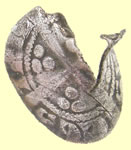 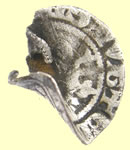
Plough damaged coins |
7th Jan 2009 More missed finds and new export procedure
I agreed a new procedure today with the BM to make it easier for the advisors that approve the export license to see the finds that are currently with or due to go to the museum FLO for recording from the sheets. Here is the first sheet of Vegas Mike's pouch where item's 12 and 14 are due to be recorded. On you export documents you will see this annotation now.
Metal detecting finds for export found Sept 2008. Location East of Colchester. All important finds recorded with PAS, Celtic Coin Register and Fitzwilliam museum. Finds marked with ** are with or due to taken to Colchester FLO Laura McLean. Hardcopy of list with Export forms posted to MLA.

1. 1584 Elizabeth 1st hammered silver sixpence - A mint mark 6th issue
2. 1582 - 84 Elizabeth 1st hammered silver half groat (2 pence)- A mint mark 6th issue
3. 1574 Elizabeth 1st hammered silver half groat (2 pence)- Acorn mint mark 4th issue
4. 1826 William IIII trade weight - London Crown W 6.87g
5. 16th C Henry VIII trade weight - Crown h mark London
6. 19th C T.C Nunn stores £1 token- Wix
7. 1872 Victorian milled silver shilling
8. 1770’s silver Navy Lieutenant button
9. 1770’s silver Navy Lieutenant button
11 **. 4th C Roman bronze coin - illegible
12 ** . Roman bronze decorated Amphora strap end 44.38mm L x 23.89 W 17.23g
14 **. 1st C Celtic wode grinder - 'bull head' type with broken suspension loop
15. Georgian bell type trade weight
16. Medieval bronze pot fragment
17. Georgian watch winder
18. 17th C mount with 2 integral lugs
19. 19th C T.C Nunn stores ½ guinea token- Wix
20. 16thC copper alloy jewelry clasp
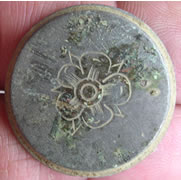 It is interesting to note that Mike found another two silver buttons with Rose designs. A few months ago the British Museum were uncertain as to the age of these finds so a whole bunch of ours plus a pair of cufflinks with the same design were sent off to their experts. They were disclaimed as not being pre 1708 to be declared treasure. I believe that these are actually Royal Navy Lieutenant - 1748 pattern as they have a striking similarity to base pewter RN buttons of that period It is interesting to note that Mike found another two silver buttons with Rose designs. A few months ago the British Museum were uncertain as to the age of these finds so a whole bunch of ours plus a pair of cufflinks with the same design were sent off to their experts. They were disclaimed as not being pre 1708 to be declared treasure. I believe that these are actually Royal Navy Lieutenant - 1748 pattern as they have a striking similarity to base pewter RN buttons of that period
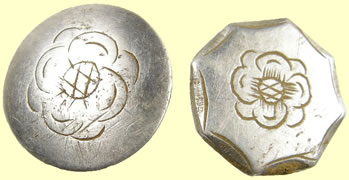
Royal Navy Lieutenant - 1748 pattern
 
I have posted another missed milled silver coin to the forum competition total.
  
Roman 4th legion military hinged strap buckle – cast marked IV – 2 rivet fixing
Legio IV Macedonica ("from Macedonia"), was a Roman legion levied by Julius Caesar in 48 BC with Italian legionaries. The legion was disbanded in 70 by Emperor Vespasian. The legion symbols were a bull (as with all of Caesar's legions) and a capricorn[1].
In 48 BC, the Roman Republic was decaying rapidly. Caesar had crossed the Rubicon River in the year before, starting a civil war. Pompey, Cato the younger and the rest of the conservative faction of the senate had fled to Greece. Caesar was preparing to follow in pursuit and, among other preparations, levied Legio IV. The first battles of the legion were Dyrrhachium and Pharsalus, where Caesar defeated Pompey. After this, the legion was stationed in the province of Macedonia, attaining thus its cognomen.
IV Macedonica sided always with Julius Caesar's adopted son, Octavian, first against Caesar's murderers in the Battle of Philippi in 42 BC, then against Mark Antony in the naval Battle of Actium in 31 BC.
Octavian, now Augustus, sent the legion to Hispania Tarraconensis in 30 BC, to take part in the Cantabrian Wars. After Augustus' victory in 13 BC, the legion remained in the province, but its effectives were spread through the Iberian Peninsula.
In 43, the legion was transferred to Germania Superior, to replace XIV Gemina as the garrison of Moguntiacum (modern Mainz). Along with XXII Primigenia, the legion supported Vitellius, governor of Germania Superior, in the Year of the Four Emperors (69), first against Otho, then Vespasian, who would become emperor in the end.
During the Batavian rebellion (69/70), IV Macedonica secured Mainz and fought under Potillius Cerealis against the rebels. Their actions deserved no reproach but Vespasian did not trust its men, probably due to their support for Vitellius. The legion was disbanded in 70, but reconstituted shortly afterwards under the name of Legio IIII Flavia Felix.
 
Medieval hanger with circule and enamel design
|
|
|
Neat 20th pressed copper harness hanger - marked Knight patent |
Medieval lead shield type hanging weight/pendant |
16thC Tudor jewelry clasp |
|
|
|
THE 27th (Inniskilling) REGIMENT OF FOOT
1855-1881
|
Our first 53rd Regiment of foot buttons - Shropshire Reg - Post 1881 |
RN Capt / Commander - 1812
Maker Mark M.S & J.D
Treble gilt - Standard Color
Interesting button - left facing stock but with American spelling of colour. MS & JD were British button makers of the 19thC
|
|
5th Jan 2009 More exports and finds - cheap flights - month to the kick off
Just under a month now to the kick off for the 2nd half of the detecting season. We are starting a month earlier this season as guys have requested special hunts due to school holidays and farming schedules back in the USA and Canada. We have a full crew now for the first 5th Feb hunt but have a couple of free slots still on the 14th Feb hunt if anyone wants to join. Our club historian Canadian Rod is here that week armed with all the latest research and new maps of the land if you are really in to history. Chicago Ron is running a Barn house hunt on the 20th March to 27th March and 27th March to 3rd April. One of his guy has just had a triple by pass op and cannot make it so there is also a free slot with Ron for either those two weeks or both. Drop me a mail if you are interested enquiries@colchestertreasurehunting.co.uk
Guys have been posting on the members forum really good cut price air fair deals they have been getting to the UK at the moment. Michigan Chris posted this link. Cheap airfairs and the pound still at 1.45 to the dollar, this recession is great news for taking a trip here.
'I was just notified that cheapair.com is having an airfare sale if you book by Jan. 7 for flights up through April.
My tickets have been purchased already for a flight from my hometown to Detroit, and then to London. They cost me $694. I checked for the new price and apparently flights from Chicago to London are on sale because the new ticket price going through Chicago instead is $585. Heck of a deal, I think.
Just thought I'd pass it on.' Chris
'That is cheap, $582 round trip from Arkansas.
It's amazing $193 for the flight and $379 for taxes'
Gary
I am still busy compiling the export paperwork for the first half of the season. Just uploaded more find sheets and pictures to the members forum. Some more interesting pieces in the export pouches including what looked like just a plain spoon handle. On closer examination it has an early crude decoration of a face. I already have a bunch of finds to take to the museum next week for recording and evaluation so I will include this handle shaped piece for their views. There was a particularly interesting early crotal bell in great condition with a heart shaped foundry mark I have not seen before.
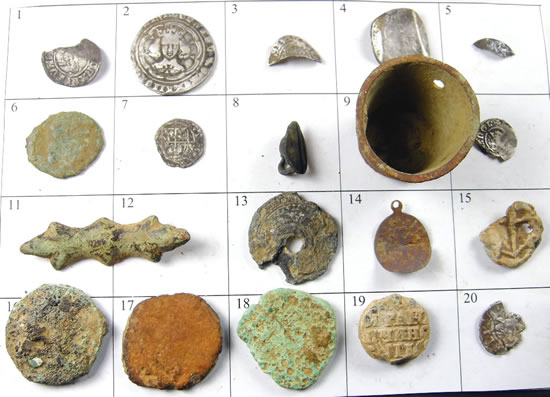
1. 1274 Edward 1st hammered silver penny - Class 10ab
2. 1356-1361 Edward III hammered silver groat (4 pence)- Standard F type - annulet in third qtr
3. 1216 Henry III hammered silver cut half penny - Class 7b Moneyer SIMVND - Bury Mint
4. 1696 William II milled silver sixpence love token
5. Hammered silver coin - fragment
6. Magnentius 352-353 AD. "Chi-Rho" or Christogram
7. 16thC Elizabeth 1st hammered silver half groat
8. 17thC mount with 2 integral lugs
9. Georgian bullion cup weight
10. 1377 -1399 Richard II hammered silver halfpenny - type 2b
11. 17thC mount with 2 integral lugs
13. Victorian pewter medallion
14. Victorian copper medallion
15. 17th C lead trade token - anchor
16. 1st /2nd C Roman bronze coin - illegible
17. 1st /2nd C Roman bronze coin - illegible
18. 1st /2nd C Roman bronze coin - illegible
19. 1836 Russian bale seal
20. Medieval hammered silver penny
  |
|
Crude face and decoration on this piece ? |
Fantastic condition decorated crotal bell with a heart foundry mark |
|
|
17th lead trade token - anchor mark |
Large Georgian lead carriage crest - Lion facing left |
|
31st Dec 2008 More exports and unpublished finds
More complete find lists published on members forum including Can Gord's amazing pouch with that very rare Celtic gold find. Texas Rob had a stunning Saxon strap end in his pouch of an unusual design which I will be taking to the museum for recording and feedback. He also had both the early Navy button types, with and without crowns, that I posted below.

1. Georgian spur buckle
2. 1490-1504 Henry VII hammered silver sovereign penny, No initial mark Archbishop Rotherham issue - key beneath shield
3. 1475 French uniface gold 'ecu au soleil' coin weight - Hexagonal French issue with sun above 3 lis in a shield
4. Georgian watch winder/fob seal
5. 16th C Tudor button
6. 1819 George III milled silver 6 pence
7. 1854 Victorian milled silver 3 pence
8. 50 BC Trinovantes Celtic gold stater 16.76mm,5.89g recorded as CCI 08.9338
9. 1815 Bank of England issue George III milled silver 1 shilling and 6 pence (18 pence)
10. 19th C 48th regiment of foot button
11. 4th C Roman bronze coin - illegible
12. Constantine Roman bronze - 335-345 AD GLORIA EXERCITVS
13. 1687 James II milled silver 3 pence
14. 1900 Victorian milled silver Florin (24 pence)
15. Medieval lead pilgrims badge
16. 19thC 97th Regiment of foot button
17. 17th C hooked mount
18. Medieval lead shield weight
19. Medieval lead token
|
|
RN Capt / Commander - 1812 with crown
RN Capt / Commander - 1787 without crown |
1625 Charles 1st penny |
|
|
2nd C Roman bronze coin |
1572 Elizabeth 1st hammered silver 3 pence |
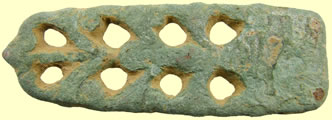


Saxon bronze strap end - 2 rivet fixing 50.77mm L x 16.98 mm W x 4.18 mm T |
29th Dec 2008 More exports and ID's
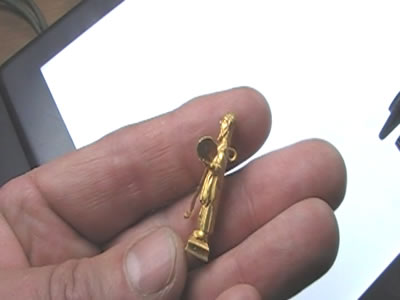
I have just updated the hoard and treasure page with the latest disclaimed treasures.

Just uploaded more export sheets and find lists to the members forum. Tenn Brad had an amazing hunt again this season with the possible 'find of the year' Medieval gold statue and an amazing array of other great finds. He found a a great set of larger hammered silver coins.
1. 1573 Elizabeth 1st hammered silver 6 pence - Acorn mintmark 4th issue
2. 1559 Elizabeth 1st hammered silver groat (4 pence) - Lis mintmark 1st issue
3. 1351-2 Edward III hammered silver groat (4 pence) Initial mark Cross 1
4. 1351-1361 Edward III hammered silver groat (4 pence) - pre treaty 3rd coinage
5. 1464/5 Edward IV hammered silver penny - Type VIIi - 0.93g, 18.07mm
6. 1549 -51 Edward VI hammered silver shilling (12 pence) - Long cross fourchee over Royal cross
7. 1582-4 Elizabeth 1st hammered silver 3 pence - 'A' mintmark
8. 1272 Edward 1st hammered silver penny Class 8a
9. 1194 -1199 AD Richard 1st hammered silver cut half penny - Type 4a Moneyer ALE(IN (Alien of Durham mint)
10. 1272 Edward 1st hammered silver penny - Cross Potent type 3g
11. Medieval hammered silver long cross penny fragment
12. 1490-1500 Henry VII hammered silver half groat - Class IIIc, Tun mintmark, one arch jeweled one arch unjeweled
13. 1341 Edward III hammered silver penny - florin type 1.04g,17.22mm
14. 1649 Commonwealth hammered silver penny
15. 1817 George III milled silver sixpence
16. 1696 William III milled silver sixpence
17. 1857 Victorian milled silver 6 pence
18. 1818 George III milled silver sixpence
19. 1818 George III milled silver sixpence
20. 1891 Victorian milled silver 6 pence

Cal Jim has been doing some great research on one of our medieval heraldic shield pendant finds. He has contacted Bruce Leeming who has been researching his family history.
'I have been researching that shield pendant with the red drops and the red canton, and I believe that I have found the family it belongs too.
I did contact a family genealogist for this family, as I noticed on the genealogy sites that he had information on the coat of arms for this family. I showed him what I had, and he agrees with me that the shield is most likely for his family. ' Jim
Bruce, the family genealogist, sent me the page below that describes the shield, silver shield with droplets of red blood. The Lemming, Leming, Lemyng family were from Essex where the shield was found by Van Brent.
I have nothing in writing that describes what you have. There are several books that list drops of blood on a shield as being Lemyng or Leming. I attach some of what I have.
The pendant almost looks like a quartered shield for a son or brother, maybe even representing a marriage.
You certainly find some interesting pieces.
Bruce

|
28th Dec 2008 New menu system
I have re vamped the menu system to make it easier to navigate this site. I will test it just on the news page to iron out any broken links, please drop me a mail if you find any problems please.
|
23rd Dec 2008 Have a great Christmas - More find lists and exports
I want to take the opportunity to wish all the members and readers of this site a very Merry Christmas and thanks for your continued support. The 2nd half of the season starts early this year on the 4th Feb so not too long too wait to the off again. there are still a few slots free if anyone fancies a hunt, check out the availability page. The exchange rate continues to be excellent as the pound is still under 1.50 to the dollar at the moment making these hunts still over 30% cheaper than last season.
I posted a huge batch of export applications off to the MLA today and uploaded more members find lists and pictures to the forum. I am still working on the ID's of outstanding buttons and Michigan Chris posted a neat link of heraldic badges used in Essex that will be of great help, great site Civic Heraldry. The button below is of Harwich origin, not sure what RWM stands for.
 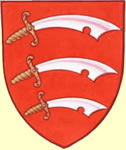 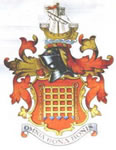
ESSEX COUNTY COUNCIL
ARMS: Gules three Seaxes fessewise in pale Argent pomels and hilts Or points to the sinister and cutting edges upwards.
Granted 15th July 1932.
HARWICH TOWN COUNCIL
ARMS: Gules a Portcullis chained Or studded and spiked Azure.
CREST: On a Wreath of the Colours upon waves of the Sea proper an Ancient Ship with one mast Or at the bow and stern Turrets and affixed below the top of the mast a Tower Argent the sail furled of the last and flying to the dexter a Pennon Gules.
Motto 'OMNIA BONA BONIS' - To the good all things are good.
Granted 15th December 1943, to the Harwich Borough Council, but used before this date.
Another couple of very early Jetton finds in the pouches I just cleaned up, both are new types for us. Check out the Jetton page. What looked initially like a grotty 19thC copper also cleaned up to be a really neat find, 1790 Halfpenny Masonic Token.
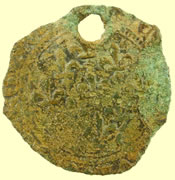 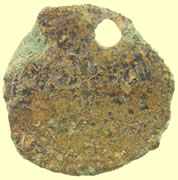 |
|
The 'Field of France' French Jetton, a field bearing numerous fleurs de lis stuck by John the Good 1350- 64 AD
9 fleurs de lis type |
1371 Feudal French Jetton – Loraine and Bar type
|
|
|
Norwich Union Society button
Norwich Union was founded in 1797 in Norwich when Thomas Bignold, a 36 year old merchant and banker formed the “Norwich Union Society for the Insurance of Houses, Stock and Merchandise from Fire”. To begin with Norwich Union was formed as a mutual insurer.
During 1808 Thomas Bignold formed a 2nd mutual called Norwich Union Life Insurance Society. In 1823 “Norwich Union Society for the Insurance of Houses, Stock and Merchandise from Fire” demutualised and was absorbed into the Norwich General Assurance Company.
It was normal at the time for insurance companies that insured against fire to have their own fire brigade which were designed to protect only the society’s policyholders property. The last private brigade was given up in 1929 in Worcester. |
London (Tower Hill). A 1790 Halfpenny Masonic Token. The central arms surrounded by the legend, "Prince Of Wales Elected Gm. 24 Nov 1790*: reverse, central cherubic triangle, "Wisdom Strength & Beauty" in Italian characters, surrounded by the legend, "Sit Lux Et Lux Fuit". The coin edge cast, "Payable London Or Dublin oxoxoll. Ref: No 26 D&h 369-372 See p.123, ills. 206/207: R.C. Bell: Commercial Coins 1787-1804, Newcastle upon Tyne, 1963 |
|
|
 |
|
Navy button H.M. Coast Guard
O/R's Button
In use 1820 - 1836 ?
button |
Navy button H.M. Coast Guard
O/R's Button
In use 1820 - 1836 ?
button |
Early pewter Crown and Rose button - could be early Navy |
Not sure what type of button this is ?
|
|
20th Dec 2008 More unpublished finds from the export pouches
More members export find sheets and photo's uploaded to the members area.
Just uploaded Canadian Gord's interesting feedback, as a newbie hunting here, to the testimonial page
More unpublished finds below including a really tiny Victorian copper with a reverse like a gold sovereign of the period, this must be a token of some sort as it is not a coin in general circulation.
|
|
1623-4 James 1st hammered silver half groat - 3rd coinage Lis mintmark |
Complete Georgian watch winder and swivel |
|
Tiny Late bust Victorian copper coin in the style of a guinea, probably a token or model coinage - Comparison size to a Victorian crown
|
|
|
|
|
| |
13th C Medieval lead coin weight - 4 pellets in each quadrant of a shield - crown above |
Prince of Wales feathers button - Army? |
Neat Essex button with RWM ? |
|
|
|
|
|
18thC Interesting hunting mount with single integral lug |
Cunard line |
1340 AD French jetton - shield of France type with fleur de lis |
|
| |
|
18th Dec 2008 Early brooch find - more unpublished finds
I had a shock while going through Chicago Ron's pouch getting it ready for export. Ron's 'Barn' team had discovered a Roman settlement on new land this season and I had already taken half a dozen of Ron's stunning Romano/British artefacts like his Celtic wode grinder, enamelled fibular brooch etc into Colchester museum for recording. I noticed this amazing fibular brooch find I had not seen and rang Ron to ask him where he found it, yep last day on the same Roman area along with a Roman bronze coin in quite good shape I had not seen either. I have just looked the brooch up in Richard Hattatt's ancient brooch book and it is possibly the earliest brooch ever found here at 6th to 3rd Century BC Iron age brooch. I am taking a huge batch of finds for ID and recording into Colchester museum so it will be very interesting to see what they eventually date this brooch as.
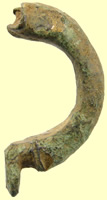  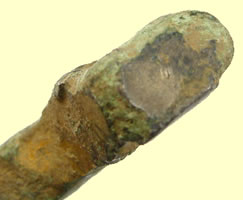 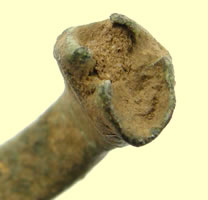
6th to 3rd Century BC Iron age brooch, some gilding remains 12.20g, 37.99mm H x 6.35mm W
 
Roman coin - sent for possible ID 18.93mm,2.87g
Mark sent me back this initial ID on the Roman, I am trying to clean it up further to get more crud off the bust to reveal the detail.
Not too much to go on - very little contrast in the photo - but could it be like these? :
Reverse is a small, square altar, surmounted by a banded globe, the altar inscribed: "VOT / IS / XX" or similar?
These usually have the legend on the reverse: 'BEATA TRANQVILLITAS" or some abbreviation thereof, and are known for a number of the members of the family of Constantine: himself, Crispus and Constantine II, but are too early for Constans of Constantius II who weren't created Caesars yet. They were only struck at the Western European mints, c. 320-323 AD. and not at all for the Licinii, I believe.
Mark
I also cleaned up what appeared to be just a nice condition George IV copper coin and was surprised to find the words 'Province of Upper Canada' on the legend. I did some research on the net and it is indeed a Canadian copper token neat relic.
 
1832 half penny token, province of upper Canada
'Upper Canada first used local tokens after 1812, when a series of lightweight halfpennies was issued in memory of Sir Isaac BROCK. These coins were superseded after 1825 by a series of tokens with a sloop on one side and various designs (eg, plow, keg, crossed shovels over an anvil) on the other. In 1822 a copper twopenny token was issued by Lesslie & Sons. The firm also issued halfpennies from 1824 to 1830. There were no government issues in Upper Canada.
When the 2 Canadas were reunited in 1841, the Bank of Montreal was allowed to coin copper; pennies and halfpennies appeared in 1842. Halfpennies were issued again in 1844. After 1849 they received the right to coin copper and large issues of pennies and halfpennies appeared in 1850, 1852, 1854 and 1857. The Quebec Bank was allowed to issue pennies and halfpennies in 1852'.
More unpublished finds below. I have added a couple of missed milled silver coins to the lasted find page, Nov 2008 finds page 2 and added them to the forum competition total.
|
|
1722 George 1st 'dump issue' copper farthing in great shape |
19thC trade token, Peel & Co Alexandria - 2 shillings
Rev - Lion facing left holding a knife
|
|
|
1573-8 Elizabeth 1st hammered silver penny |
1623-4 James 1st hammered silver half groat – Lis mintmark 3rd coinage |
 
Roman tulip shaped pin head
|
|
|
|
19thC corporation button |
19th C livery button |
19th C livery button |
Georgian dress button |
|
|
|
|
17th C button |
19th C livery button |
Georgian dress button |
|
|
16th Dec 2008 Members vid and more button ID's
 More find sheets and photo's uploaded to members area. Oregon Ed has written an interesting article on musket and minnie balls and their history for a local paper click here to view More find sheets and photo's uploaded to members area. Oregon Ed has written an interesting article on musket and minnie balls and their history for a local paper click here to view
Canadian Bill sent me a bunch of great vids he took while out in the field which I have just uploaded to the members area. They include the one when he found the oldest coin ever found here and the evening when Tenn Brad found that amazing medieval gold statue. I have just updated the post of the 14th Dec with more button ID's just in from Tim.
 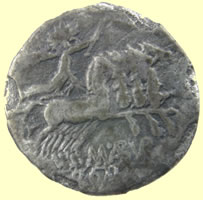 
As dug to 'cooked' Oldest coin ever found here so far 132BC and after it was 'cooked'
It's clear enough now for a positive ID - it is definitely a Roman Republican Denarius - moneyer: M Aburius M.f. Geminus, 132 B.C.
RSC-Bab Aburia 6, SR 127, Syd-CRR 487.
You should, eventually, find the letters: "GEM", behind Roma's helmeted head on the obverse, and there should be an asterisk-looking mark under her chin which is actually a monogram of XVI - ie: 16 Asses to the denarius. On the reverse, you have radiate Sol driving a fast quadriga right and brandishing a whip, below the horses, you have M ABVRI with the AB and VR in ligate form, ROMA in the exergue.
Very interesting, as this piece dates to a century and three-quarters before Claudius' conquest of Britian. I'm going to guess that it originally came to the island in trade for tin, or was carried as a good-luck piece by a superstitious soldier all those years later. These certainly weren't normal, circulating pieces anywhere else in the Empire in the late 1st through early 3nd century era we associate with a significant Roman presence in Britain and circulating silver. These were "overweight" by the standards of the denarii at that time and after Nero's debasement, the silver was too pure also - these would have been pulled out of circulation wherever anyone knew that their silver value was well above their nominal denomination - the sort of information that any savvy merchant would have been aware of.
 

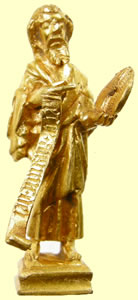 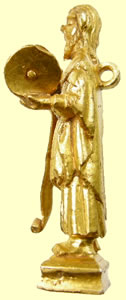 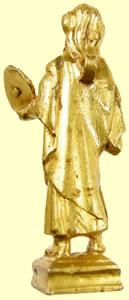

Script reads FRCO ++SMYUNC +DEI
32.80mm H ,11.46g
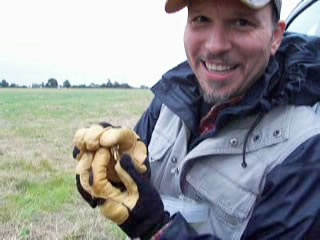
Brad's Video just after he dug it
The medieval gold statue is currently with the British Museum being evaulated and the initial feedback is it is a very significant find.
|
|
|



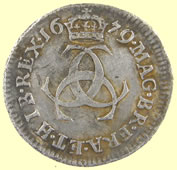

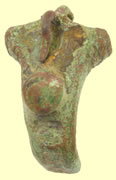
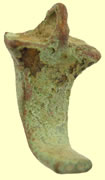
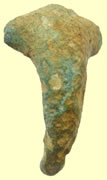
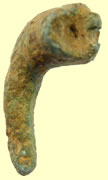

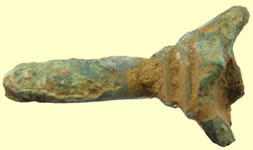
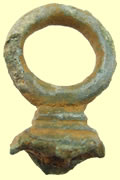

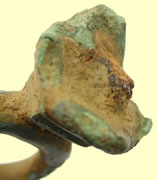

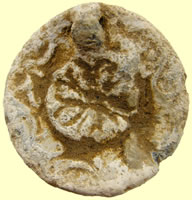

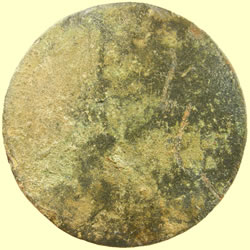

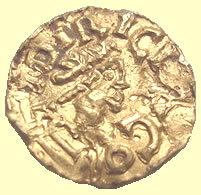
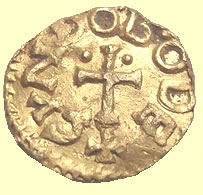
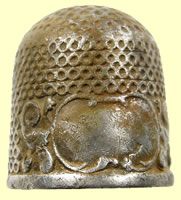
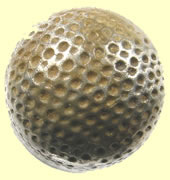
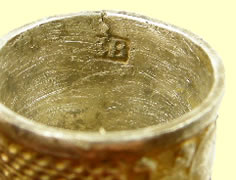





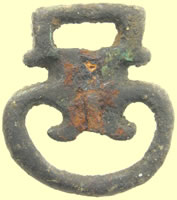
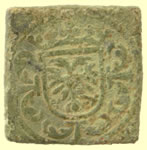

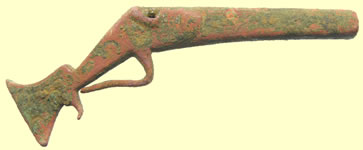
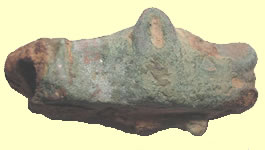
 Updated both the Charles 1st and 2nd individual finds pages with the latest finds and a few more finds I missed including this stonking 88th Regiment of foot button. It is not listed in my ref books but it is circa 1790.
Updated both the Charles 1st and 2nd individual finds pages with the latest finds and a few more finds I missed including this stonking 88th Regiment of foot button. It is not listed in my ref books but it is circa 1790.
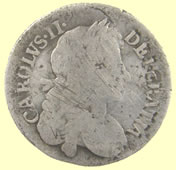
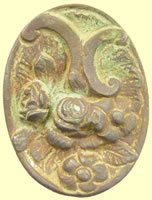
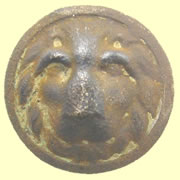
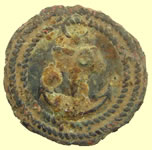

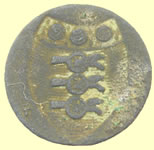
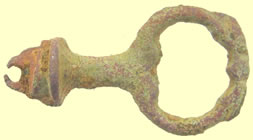





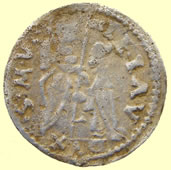












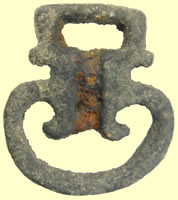
























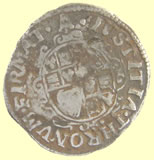
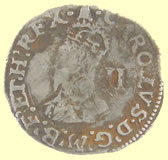

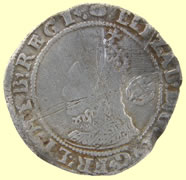

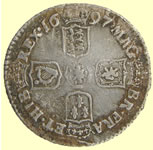


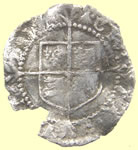
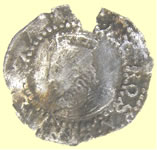













 'A badge for a Knight of the Order of the Holy Sepulchre in bronze and dating somewhere around C13/14th possibly very slightly later . This is a very scarce item and it relates to The Equestrian Order of the Holy Sepulchre of Jerusalem being a Catholic chivalric order of Knighthood that traces its roots to Godfrey of Bouillon, principal leader of the First Crusade. According to reliable sources in the Vatican and Jerusalem, it began in historical reality as a mixed clerical and lay confraternity (association) of pilgrims which gradually grew around the most central of the Christian holy places in the Middle East, the Holy Sepulchre or the tomb of Jesus Christ.This would have been a pin for a member of the order , there is a mark on the reverse where the original pin would have been fixed
'A badge for a Knight of the Order of the Holy Sepulchre in bronze and dating somewhere around C13/14th possibly very slightly later . This is a very scarce item and it relates to The Equestrian Order of the Holy Sepulchre of Jerusalem being a Catholic chivalric order of Knighthood that traces its roots to Godfrey of Bouillon, principal leader of the First Crusade. According to reliable sources in the Vatican and Jerusalem, it began in historical reality as a mixed clerical and lay confraternity (association) of pilgrims which gradually grew around the most central of the Christian holy places in the Middle East, the Holy Sepulchre or the tomb of Jesus Christ.This would have been a pin for a member of the order , there is a mark on the reverse where the original pin would have been fixed 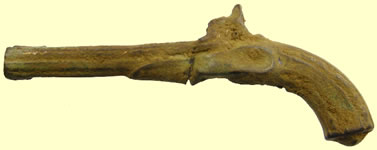
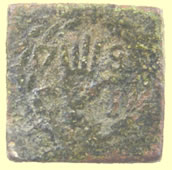
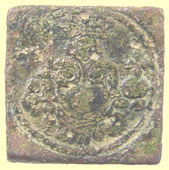


















































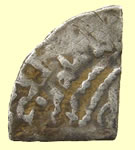

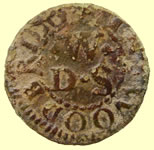































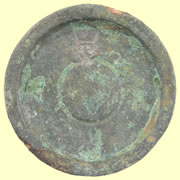















































 =
=







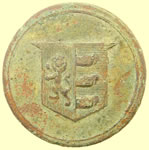
























 Denomination:
Denomination:






















 Marianchem just posted a really neat find from Serbia on the forum thinking it was Roman. It is in fact a 16thC Tudor period pin and amazingly in one piece. We have found two pin heads of that style which were sent to the British museum as treasure, they were dated as 16thC.
Marianchem just posted a really neat find from Serbia on the forum thinking it was Roman. It is in fact a 16thC Tudor period pin and amazingly in one piece. We have found two pin heads of that style which were sent to the British museum as treasure, they were dated as 16thC.





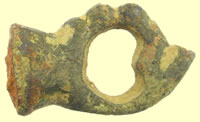
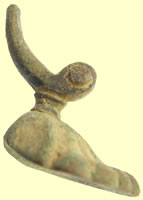



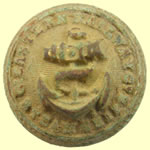




.jpg)
.jpg)
.jpg)

















 It is interesting to note that Mike found another two silver buttons with Rose designs. A few months ago the British Museum were uncertain as to the age of these finds so a whole bunch of ours plus a pair of cufflinks with the same design were sent off to their experts. They were disclaimed as not being pre 1708 to be declared treasure. I believe that these are actually Royal Navy Lieutenant - 1748 pattern as they have a striking similarity to base pewter RN buttons of that period
It is interesting to note that Mike found another two silver buttons with Rose designs. A few months ago the British Museum were uncertain as to the age of these finds so a whole bunch of ours plus a pair of cufflinks with the same design were sent off to their experts. They were disclaimed as not being pre 1708 to be declared treasure. I believe that these are actually Royal Navy Lieutenant - 1748 pattern as they have a striking similarity to base pewter RN buttons of that period











